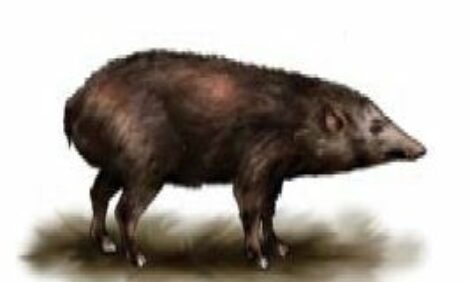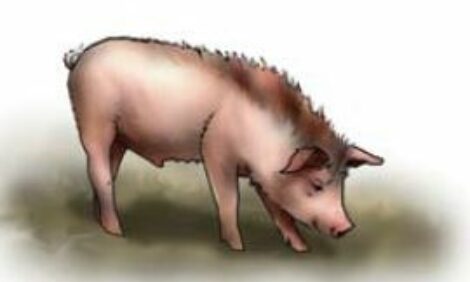



Mulefoot
Mulefoot are a breed of domestic pig which is named for its intact, uncloven hooves reminiscent of a mule. These pigs are typically black, on rare occasions having white markings, and typically reach a weight of 400 to 600 pounds (180 to 270 kg), with males averaging 550 pounds (250 kg) and females 450 pounds (200 kg). The breed thrives when raised on pasture (as opposed to in confined feed lots), and has retained the ability to forage for food. The sows are known as good mothers, having litters that average 5 to 6 piglets. The breed is known as being especially hardy.
The Mulefoot likely originated with swine brought to the Gulf Coast by the Spanish, exactly when they originated is not clear however. While pigs with single hooves are found in writings as far back as Aristotle, the Mulefoot is the only population to be considered a breed, with an established standard type and extensive agricultural usage. The breed is possibly related to the Choctaw pig, and may share a similar ancestry. The Spanish-descended stock was minimally managed, with some selective breeding, which continued into the late 1800s, due to its hardy nature and free-ranging rearing preference. Breed standards for the Mulefoot arose around 1900, and its ability to fatten quickly meant was used mainly for the production of meat and lard, with its hams being particularly prized. The breed was seen mainly in the Corn Belt and Mississippi River Valley. The early 20th century saw the breed at the peak of its popularity, with over 200 purebred herds and two breed associations. At the same time, some Mulefoots were exported to Canada, but the population was not maintained.
In the mid-20th century, the population began to decline, and by 1964, one breeder, R.M. Holiday of Louisiana, Missouri, established what would become the last herd of purebred Mulefoot hogs. He acquired stock from all known purebred breeders, and used selective breeding to maintain the breed standard. By 1976, the registries for the breed closed, and the herd books, pedigrees and other registration information was lost. In 1993, Mark Fields and the American Livestock Breeds Conservancy (later The Livestock Conservancy) began working with Holiday to re-establish the breed registry and expand breeding programs to additional farms.
As of 2013, The Livestock Conservancy considers the Mulefoot to be critically endangered, a categorization given to breeds with a population of fewer than 2,000 and yearly registrations of fewer than 200. As of 2006, there were estimated to be fewer than 200 purebred Mulefoot hogs in existence. Maveric Ranch took over conservatorship of the Mulefoot Breed in 2006. To date they have placed breeding groups on over 40 farms across the USA.








